In the last entry, I know I started with a fancy intro talking about weird fiction that might have led you to believe I was going to get all high falootin’ trying to educate you on history and stuff. Well, fret not, dear folks! I am far too lazy to do that kind of intro with every installment. I will not apologize for my lackadaisical approach to blogging (or whatever the hell this is). Instead, I’ll give you another batch of write-ups to scratch that odd itch you might get sometimes just below the sternum. Oooh yeaa… That’s the itch right there… Anyway, this time I’ve got a darkly feminist(?) collection of fairy tales, a collection of classic public domain horror, a tragic tale of a family being pulled asunder, a wild western infused with cosmic horror and one of the grandfathers of cosmic horror itself.
Also for those just joining me, this is my journey through the following “Best of” Horror lists:
Reedsy Discovery Best Horror Books
Stephen Jones & Kim Newman’s Horror: 100 Best Books
Stephen Jones & Kim Newman Horror: Another 100 Books
If you want to check out my previous entries, they can be found here:
Part 8 | Part 7 | Part 6 |Part 5 | Part 4 | Part 3 | Part 2 | Part 1
Now let us dim the lights low, huddle around your phone or laptop, and bask in the warm glow of death and delirium.
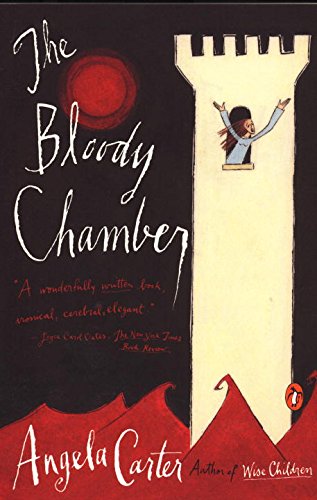
The Bloody Chamber and Other Stories (Angela Carter, 1979)
Lists: NPR, Reedsy Discovery and Jones/Newman
Angela Carter reimagines classic fairy tales with a more feminine bent. I maintain that while this is often cited as feminist literature, several of these seem almost anti-feminist unless the intent is to show how women are degraded and abused. In that way I suppose they may be considered feminist in the same way something like I Spit on Your Grave is considered feminist. Regardless of whether this is feminist or not, it is certainly very feminine, injecting elements of the female gaze into these stories that weren’t there or may have only been inferred in the original tales. The stories themselves are also a mixed bag. The title story, a riff on Bluebeard is one of the better and more overtly unsettling of the stories. It captures a sumptuous gothic horror atmosphere that serves as a good fit for Carter’s Victorian-inlfuenced prose. The two variants on Beauty & the Beast, one a more traditional version and one infused with a kind of raw sexuality, are both some of the weaker stories in the book in my opinion. This repetitive series of adaptations of the same story would be applied to better affect with the trio of wolf stories the book closes with. The first of these, “The Werewolf”, is a sly and subtly clever little twist on the barebones Little Red Riding Hood story while its follow-up “The Company of Wolves” is a more lurid and unsettling version of the same story with an ending that evokes a kind of sexual awakening and empowerment that does strike me as one of the more feminist stories in the book. The final story “Wolf-Alice” is less a Red Riding riff and more a story of a girl raised by beasts who is forced to confront her own sexuality and enter the world of men, whether prepared or not.
As far as the rest go, “Puss-in-Boots” is probably the worst in the book, a crass and silly nothing of a story. “The Erl-King” is strange and abstract, almost poetic in its style rather than traditional prose. “The Snow Child”, like “The Courtship of Mr. Lyon”, is one of the most straight-forward and traditional of the stories but is decently effective at what it is intending to convey. “The Lady of the House of Love”, a parable of loss of virginity seen through the eyes of The Countess, a vampire, who gives herself over to humanity which leads to her undoing, had some interesting ideas but was honestly hindered at times by its overly prosaic prose style. Still like “The Bloody Chamber” it does at times conjure up some wonderful gothic imagery.
Overall, I can’t say I was as enamored with this collection as many literary critics seem to be (but then navel-gazing is a national pastime in critics’ circles) but it does offer some things worth checking out, especially for those who are fans of gothic fiction. It also left me curious to rewatch the Neil Jordan film The Company of Wolves that was based on the story of the same title from here.
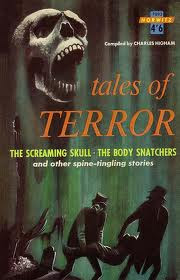
Tales of Terror (Edited by Charles Higham, 1961)
This is an old paperback collection of classic horror tales, some of which I had read before like W.W. Jacobs’ “The Monkey’s Paw”, Poe’s “The Tell-Tale Heart” and F. Marion Crawford’s “The Upper Berth” which are all fine classics of the genre. Additionally we have a couple from Bram Stoker, the best of which is his werewolf story “Dracula’s Guest” as well as Wilkie Collins’ (father of the detective novel) tale “The Dead Hand”, an interesting story that starts with a guy realizing he has taken a hotel room for the night with a corpse and finding it only getting stranger from there. Crawford’s other story “The Screaming Skull” is ok but honestly too long for what it is. There’s also an abridged version of “Queen of Spades” which I had just read a week before as well as Robert Louis Stevenson’s “The Body Snatcher” and Dickens’ “The Signalman” a good idea ruined by Dickens’ complete inability to write something even remotely spooky (the BBC adaptation from 1976 is significantly better than the original story in my opinion). Overall this is a solid, if brief, collection that includes some essential horror tales.
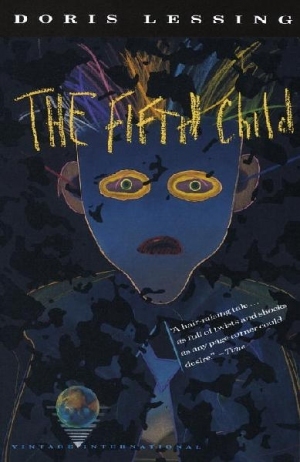
The Fifth Child (Doris Lessing, 1988)
List: Reedsy Discovery
This one hurt. This is not a horror of vicious monsters drinking blood and rending limbs. It’s something far more personal and heartbreaking. It’s the slow motion trainwreck of a joyous, happy family being slowly destroyed by a mother’s love (or pity?) for a brutish troll of a son. Told like a dark fairytale that slowly twists a knife deeper and deeper, we follow a young couple, David & Harriett, who desires to have a large family with 6 to 8 children in brazen defiance of their societal norms and families’ wishes. And for a long time they get it. Within a few short years, they are blessed with four wonderful children and while financially they are strained at times, they make things work with the help of the extended family. All that changes when Harriet becomes pregnant with their fifth child. Even in the womb, this child is brutish and violent. Once born, things don’t get better. The kid is ugly, mean and immediately starts to splinter the family. Extended relatives stop visiting. The other four children become more and more miserable around the new child as he murders pets with surprisingly strength. When the family finally makes the decision to spirit him away to an institution for their own sake and sanity, Harriet eventually lets her motherly instincts get the better of her and makes a decision that sends the whole family spiraling apart. It’s a short novel but with no chapter stops, it has a kind of momentum of building dread and sorrow that almost demands to be read in one sitting. It’s a very good book but absolutely agonizing to read, especially if you are a parent, knowing the impossible decisions Harriet makes and the consequences of them.
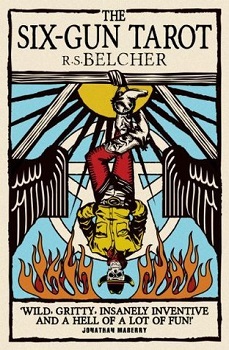
The Six-Gun Tarot (R. S. Belcher, 2013)
List: Reedsy Discovery
I finished the (very well-done) audiobook of this one yesterday. The Six-Gun Tarot is a heady blend of weird west meets Native American and Chinese mysticism meets cosmic horror and follows the eccentric denizens of the small Nevada town of Golgotha. There’s Mutt, half Native American, half something much stranger, a town deputy who finds 15-year old Jim dying out in the desert and in possession of an incredibly powerful piece of Jade gifted to his father by a Chinese mystic. The Sheriff of the town is John Highfather, a man with his own demons who claims he can’t be killed with the rope burns around his neck to prove it. Harry Pratt is the reluctant mayor and elder of the local Mormon church who harbors a secret that would ostracize him from society. Maude Stapleton, wife of asshole banker Arthur, and daughter of Lilith upon whose shoulders rests “The Load”. When a world-ending celestial event threatens to destroy not just the town but the entire world, these people are the only hope of both angels and devils alike in preventing The Old One and it’s black goo-oozing worshippers from rising from the void to devour everything.
This one was a lot of fun with a well-developed group of characters and an interesting premise. Belcher captures the spirit of a wild west town quite well with a mostly very good pacing. There are a couple of somewhat superfluous plot lines that I question their relevancy in the overarching story (although since this is the first in a series, Belcher may intend to build them out further in future volumes). One thing I actually liked quite a bit about this one is that rather than focusing on the more obvious “leading man” hero type character of the sheriff, he actually puts Mutt front and center and the real glue holding much of what’s happening together. Recommended if you like highly eccentric westerns and Lovecraftian world-ending horror.
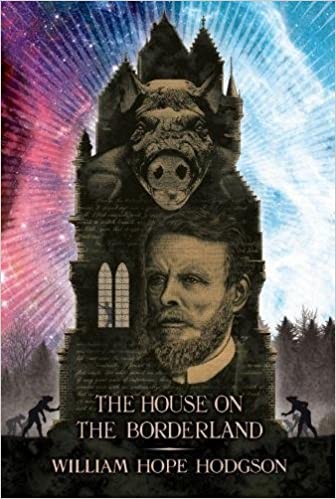
The House on the Borderland (William Hope Hodgson, 1908)
List: Jones/Newman
“Despite the vicious swine creatures coming out of the pit, my dog turning to dust and the mind-altering cosmic journeys through the chaotic infinite, I’m just not sure I want to leave this house. I mean, I’ve already put a down payment on it, I ordered new wallpaper…” So setting aside the extremely hard-to-believe motivations for why the narrator of the found manuscript in this novel doesn’t flee this house at the first sight of a strange pig man trying to kill him, this was a pretty interesting and what I would imagine would be a somewhat revelatory work of weird fiction of it’s time. Much lip service has been given to how big a fan of Hodgson H. P. Lovecraft was, and it’s easy to see that this book in particular had to have been a major influence on Lovecraft both in the more grounded creeping horrors of “Shadows Over Innsmouth” and in the stranger more cosmic bizarre stories of “The Dream-Quest of Unknown Kaddath”. On its own merits, it’s a little uneven to be honest. Hodgson is capable of building up a great atmosphere of mysterious dread with the THINGS from the PIT but where I thought the book faltered a little is in how long the cosmic out-of-body sequences were. They play out like the end of 2001: A Space Odyssey in book form, describing his witness to the death of the solar system as he hurtles through the cosmos, seeing it collapse into a central green sun. There are some pretty imaginative ideas here but they comprise about a third of the book which just feels too long and distracts from the more sinister and immediate threats. Still, the importance and impact of William Hope Hodgson can’t be denied, and this is definitely recommended for fans of Lovecraft and cosmic horror that wants to look at the roots of the sub-genre.

